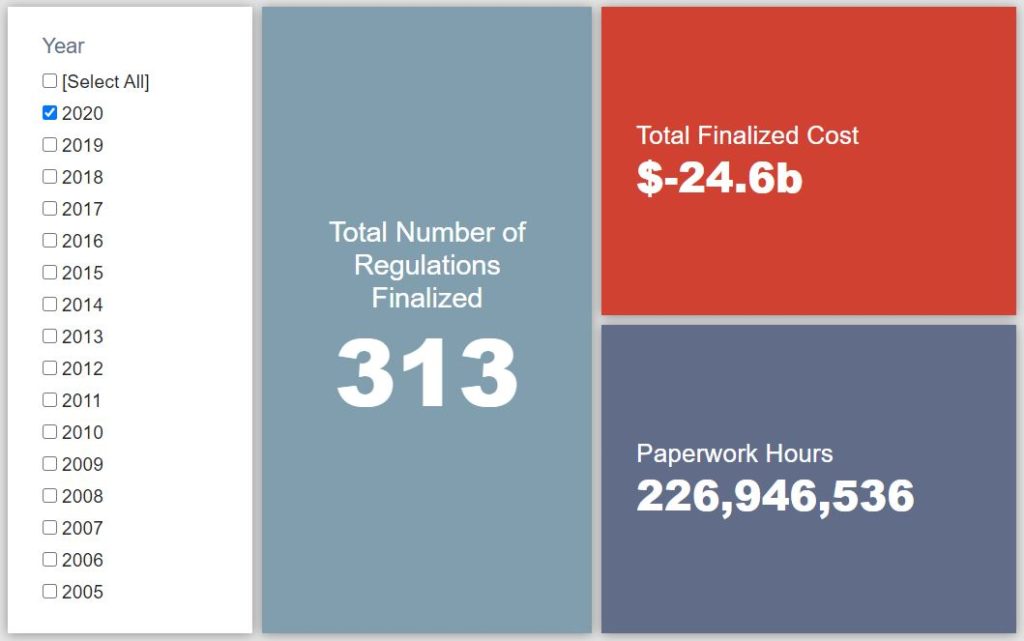Week in Regulation
October 13, 2020
Immigration Rule Brings Significant New Costs
There were nearly two dozen actions last week with some kind of measurable economic impact. Topics varied from assistance for “microentrepreneurs” to railroads to “Test Procedure and Labeling Requirements for Dedicated-Purpose Pool Pump Motors.” The main bulk of costs, however, came from a single rulemaking regarding the standards for an H-1B visa. Across all rulemakings, agencies published $4.2 billion in total net costs but cut 397,056 hours of annual paperwork.
REGULATORY TOPLINES
- Proposed Rules: 40
- Final Rules: 91
- 2020 Total Pages: 64,295
- 2020 Final Rule Costs: -$24.6 billion
- 2020 Proposed Rule Costs: $16.4 billion
TRACKING THE REGULATORY BUDGET
The most significant rulemaking with regards to the fiscal year (FY) 2021 regulatory budget is an interim final rule from the Department of Homeland Security (DHS) on “Strengthening the H-1B Nonimmigrant Visa Classification Program.” The rule seeks to make a series of changes that would make the criteria and qualification process for an H-1B nonimmigrant visa more stringent. DHS estimates that the administrative burdens created by these revised requirements would yield $292 million in new annual costs, or roughly $4.2 billion in present value terms. Of note, the rule forgoes the normal notice-and-comment process, citing the need “to urgently respond to the COVID-19 resulting economic crises.” This is the second week in a row where the most consequential rule of the week avoided this typical procedure.
Since last week was the first full week of the fiscal year, the administration’s new FY 2021 regulatory budget caps are still forthcoming. So far into FY 2021, however, agencies have officially published 6 deregulatory actions and 4 regulatory actions, totaling $4.1 billion in quantified total net costs. The American Action Forum’s review of the administration’s FY 2020 regulatory budget progress can be found here.
THIS WEEK’S REGULATORY PICTURE
This week, the Federal Railroad Administration (FRA) allows for more flexibility in rail safety inspections due to technology improvements.

Source: https://www.federalregister.gov/documents/2020/10/07/2020-18339/rail-integrity-and-track-safety-standards
In the October 7 issue of the Federal Register, the FRA published a final rule on “Rail Integrity and Track Safety Standards.” The rule covers how the owners of rail track, primarily railroads, must monitor tracks to identify and prevent failures that could lead to accidents. It also shows how agencies can use trial programs to find more efficient ways to ensure safety.
The rule acknowledges new advances in safety inspections, including continuous testing, where a vehicle with ultrasonic testing equipment is used to identify potential rail defects. Previously, any potential defect in a track had to be inspected within four hours, which necessitated shutting down the testing equipment while inspectors checked the track in question. This led to delays and traffic backups, according to the FRA. The new rule removes the four-hour requirement for track owners using continuous testing, allowing the testing vehicle to proceed along the track preventing backups. The track can now be manually inspected at off-peak hours to reduce delays.
The final rule is the result of a successful trial program implemented by FRA in 2009. Since then, track owners have been able to apply for waivers of track testing requirements in order to use continuous testing over certain sections of track. FRA determined from these waivers that continuous testing is a successful inspection strategy and will improve overall safety. Accordingly, FRA is now allowing it to be used nationwide without a waiver, assuming certain parameters are met.
The final rule comes with estimated cost savings of $121.9 million that will count towards the Department of Transportation’s yet-to-be-announced FY 2021 regulatory budget.
TOTAL BURDENS
Since January 1, the federal government has published $8.2 billion in total net cost savings (with $24.6 billion from finalized rules) and 278.8 million hours of net annual paperwork burden increases (with 226.9 million hours due to final rules). Click here for the latest Reg Rodeo findings.












